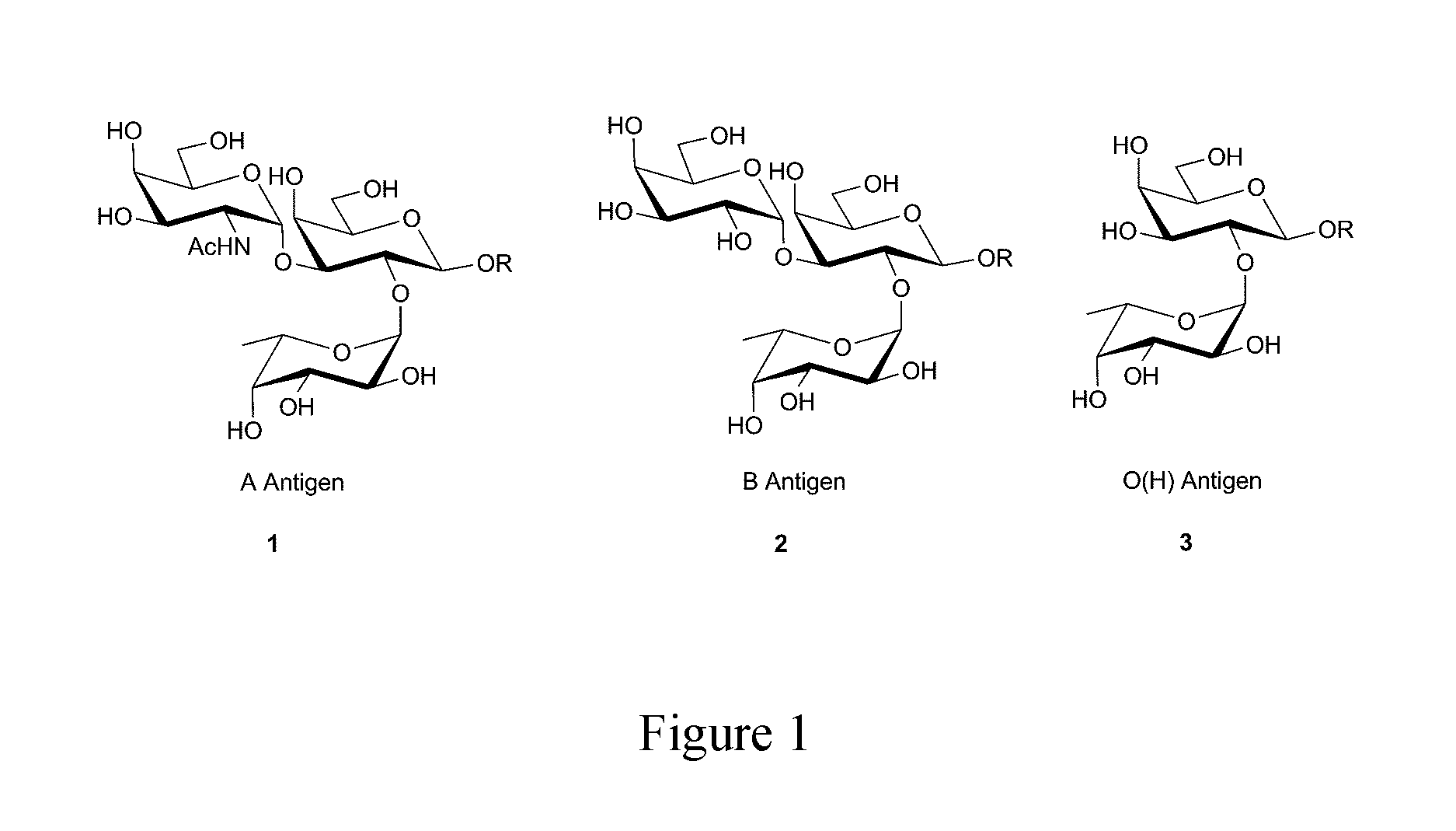Method and system for abo antibody detection and characterization
a technology of applied in the field of methods to identify, can solve the problems of inability to find the patient's blood typing, inability to identify the patient, and inability to use a method or system, so as to achieve the highest degree of safety, improve accuracy and efficiency, and achieve precise and comprehensive abo antibody detection and characterization.
- Summary
- Abstract
- Description
- Claims
- Application Information
AI Technical Summary
Benefits of technology
Problems solved by technology
Method used
Image
Examples
example 1
Evaluation of a Blood Group-0 Individual
[0129]Plasma from a blood group-0 individual was analyzed using the glycan array and bound antibodies were detected using anti-human IgM-DyLight649. The array used in this example included an α-Gal positive control as shown in the schematic in FIG. 5. As seen in the fluorescent image in FIG. 7, this blood group-0 individual produced antibodies specific for all 12 A- & B-subtypes as well as H type V (absent in human tissues), but lacked antibodies to all other H-subtypes. As noted above, α-Gal is a non-human antigen similar to the ABO antigens and the signal corresponding to the location of the α-Gal antigen shown here indicated the reaction of anti-α-Gal antibodies in the plasma sample from the individual with the immobilized α-Gal antigen on the array.
[0130]Plasma from a blood group-0 individual was analyzed using the glycan array for both IgG (FIG. 6) and IgM (FIG. 7) isotype antibodies towards the ABO subtypes. All blood group-O individuals...
example 2
Pre- and Post-Transplant Monitoring of Antibodies Using Glycan Array
[0132]ABO subtype I-VI antigens are differentially expressed in tissues and organs in a secretor-dependent or independent manner. In the setting of ABO-incompatible organ transplantation, assessment of antibodies against each subtype is crucial for a given organ. In the heart, for example, only type II ABH antigen structures are expressed in vascular endothelia and it would be important to measure antibodies against type II antigens (donor-specific antibodies) following ABO-incompatible heart transplantation.
[0133]The glycan array is a useful tool for ascertaining reliably the presence / absence of donor-specific antibodies after ABO-incompatible transplantation. Until now, the traditional agglutination assay was the only means to follow ABO antibody titres in patients in the months and years following ABO-incompatible transplantation. Without the knowledge of which ABO subtype antibodies are actually present, an unex...
example 3
Use of Glycan Array in ABO-Compatible Transplant and Transfusion
[0135]Blood group-A individuals generally develop natural antibodies against B antigens that are not expressed in their cells and tissues but not against self-antigens (A) that are widely expressed in cells and tissues throughout the body (FIG. 9). A type I antigens, however, are expressed only in lining epithelia and glandular epithelia in a secretor-dependent manner (Fujitani, N., et al., Glycoconj. 12000, 17(5): 331-338; and Fujitani, N., et al. J. Histochem. Cytochem. 2000, 48(12): 1649-1656). Although erythrocytes generally do not synthesize type I ABH structures, their expression in secretors is due to absorption of circulating glycolipids from plasma (Clausen, H. and S. Hakomori Vox Sang 1989, 56(1): p. 1-20). Therefore, in this manner some individuals who are non-secretors may develop serum antibodies against A type I antigens not expressed in their cells and tissues (FIG. 10). Transfusion related complications ...
PUM
| Property | Measurement | Unit |
|---|---|---|
| humidity | aaaaa | aaaaa |
| pH | aaaaa | aaaaa |
| concentration | aaaaa | aaaaa |
Abstract
Description
Claims
Application Information
 Login to View More
Login to View More - R&D
- Intellectual Property
- Life Sciences
- Materials
- Tech Scout
- Unparalleled Data Quality
- Higher Quality Content
- 60% Fewer Hallucinations
Browse by: Latest US Patents, China's latest patents, Technical Efficacy Thesaurus, Application Domain, Technology Topic, Popular Technical Reports.
© 2025 PatSnap. All rights reserved.Legal|Privacy policy|Modern Slavery Act Transparency Statement|Sitemap|About US| Contact US: help@patsnap.com



